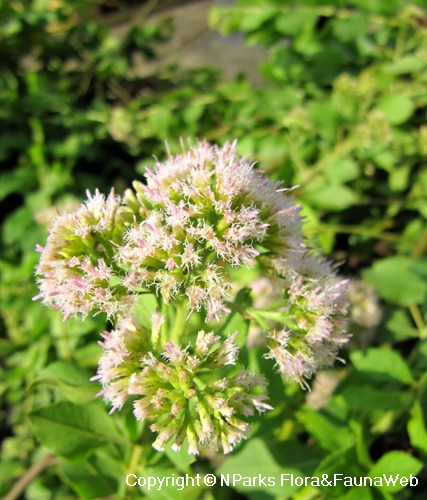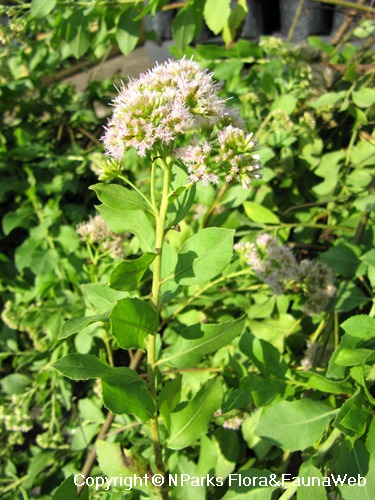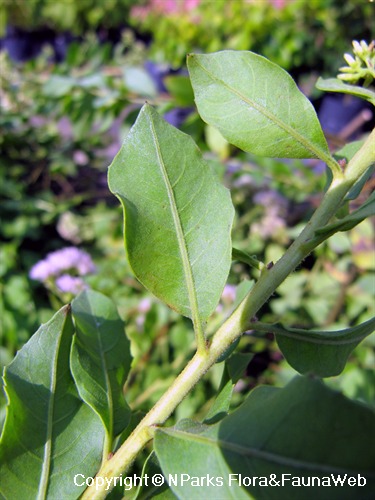
Back
Pluchea indica L.
| Family Name: | Asteraceae (Compositae) |
| Common Name: | Indian Camphorweed, Indian Fleabane, Indian Pluchea, 阔苞菊 |
Name
Classifications and Characteristics
| Plant Division | Angiosperms (Flowering Seed Plants) (Dicotyledon) |
|---|---|
| Plant Growth Form | Shrub |
| Lifespan (in Singapore) | Perennial |
| Mode of Nutrition | Autotrophic |
| Plant Shape | Shrubby |
| Maximum Height | 3 m |
Biogeography
| Native Distribution | From India to Southern China, through Southeast Asia to Australia and the Pacific Islands |
|---|---|
| Native Habitat | Shoreline (Mangrove Forest, Backshore) |
| Preferred Climate Zone | Tropical, Sub-Tropical / Monsoonal |
| Local Conservation Status | Native to Singapore (Least Concern (LC)) |
Description and Ethnobotany
| Growth Form | It is a rather bushy and upright shrub up to 3 m tall. |
|---|---|
| Foliage | Its alternate, stalkless or shortly-stalked leaves have membranous leaf blades that are toothed, usually drop-shaped, and 2.5–8 by 1–5 cm. An aroma is produced when the leaf blades are crushed. |
| Flowers | Its tubular flowers develop in pink or purplish-pink heads that are 7 mm wide. Its flower heads are found together in clusters or on branched shoots, at the leaf axils or the end of leafy twigs. Its flowers have a cup-like structure of white hairs that are spreading and 3–4 mm long. |
| Fruit | Its indehiscent fruit (fruit that does not open to release its content when it is ripe) is brown, dry, one-seeded, cylindrical, five-ribbed, and 1 mm long. |
| Habitat | It grows along the seashores and in tidal swamps. It occurs locally along Upper Boon Keng Road, in Kranji area, Pulau Ubin, and Pulau Tekong. |
| Associated Fauna | Its flowers are pollinated by butterflies as well as other insects. It is also the preferred local food plant for caterpillars of the moth, Lobesia rhombophora. |
| Cultivation | It can be propagated by seed as well as stem cutting. |
| Etymology | Latin Pluchea, commemorating a French naturalist, N.A. Pluche (1688–1761); Latin indica, of India, but also applies to plants originating throughout the East Indies, referring to one locality in the natural distribution of this species |
| Ethnobotanical Uses | Edible Plant Parts : Edible Leaves, Edible Stems Food (Fruit or Vegetable) Medicinal: The leaves and stems contain antioxidants and other compounds which have anti-acetylcholinesterase activity (Noridayu et al 2011). Other compounds with this activity have been used to treat Alzheimer's disease. Further investigation is needed to examine whether Pluchea indica shoots can be effective against Alzheimer's. |
Landscaping Features
| Landscaping | It is suitable for streetscapes, parks and gardens for its silvery-looking leaves. |
|---|---|
| Desirable Plant Features | Ornamental Flowers, Ornamental Foliage |
| Landscape Uses | Suitable for Roadsides, Parks & Gardens, Coastal, Beachfront / Shoreline, Hedge / Screening, Riverine |
| Thematic Landscaping | Silver Garden, Water Garden, Bird & Wildlife Garden |
Fauna, Pollination and Dispersal
| Fauna Pollination Dispersal Associated Fauna | Butterfly-Attracting (Flower Nectar) |
|---|---|
| Pollination Method(s) | Biotic (Fauna) |
| Seed or Spore Dispersal | Abiotic (Water) |
Plant Care and Propagation
| Light Preference | Full Sun |
|---|---|
| Water Preference | Lots of Water, Moderate Water, Little Water |
| Rootzone Tolerance | Drought Tolerant, Moist Soils, Waterlogged Soils (Drains Site), Well-Drained Soils, Saline Soils / Salt Spray, Fertile Loamy Soils |
| Propagation Method | Seed, Stem Cutting (Herbaceous) |
Foliar
| Foliage Retention | Evergreen |
|---|---|
| Mature Foliage Colour(s) | Green - Light Green, Silver / Grey |
| Mature Foliage Texture(s) | Thick |
| Foliar Type | Simple / Unifoliate |
| Foliar Arrangement Along Stem | Alternate, Spiral |
| Foliar Attachment to Stem | Petiolate, Sessile |
| Foliar Shape(s) | Non-Palm Foliage (Obovate, Oval) |
| Foliar Venation | Pinnate / Net |
| Foliar Margin | Serrate / Toothed |
| Foliar Apex - Tip | Acute |
| Typical Foliar Area | Microphyll ( 2.25cm2 - 20.25 cm2 ) |
| Typical Foliar Size | 2 cm to 6 cm |
Floral (Angiosperm)
| Flower & Plant Sexuality | Bisexual Flowers |
| Flower Colour(s) | Cream / Off-White, Pink |
|---|---|
| Flower Grouping | Cluster / Inflorescence |
| Flower Location | Axillary, Terminal |
| Flowering Period | Free-Flowering |
| Flowering Habit | Polycarpic |
Fruit, Seed and Spore
| Mature Fruit Colour(s) | Brown |
|---|---|
| Fruit Classification | Simple Fruit |
| Fruit Type | Indehiscent Dry Fruit , Achene |
References
| References | Noridayu AR, Hii YF, Faridah A, Khozirah S, Lajis N. 2011. Antioxidant and antiacetylcholinesterase activity of Pluchea indica.. International Food Research Journal. 18. 3. 925-929 |
|---|
Image Repository
Others
| Master ID | 30749 |
|---|---|
| Species ID | 5078 |
| Flora Disclaimer | The information in this website has been compiled from reliable sources, such as reference works on medicinal plants. It is not a substitute for medical advice or treatment and NParks does not purport to provide any medical advice. Readers should always consult his/her physician before using or consuming a plant for medicinal purposes. |


